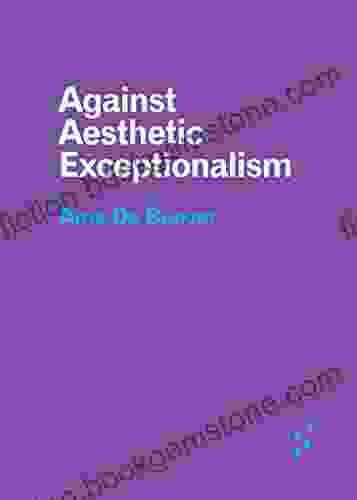Against Aesthetic Exceptionalism: A Historical Perspective on Forerunners of Inclusion and Accessibility in Design

4.5 out of 5
| Language | : | English |
| File size | : | 1450 KB |
| Text-to-Speech | : | Enabled |
| Enhanced typesetting | : | Enabled |
| Word Wise | : | Enabled |
| Print length | : | 130 pages |
| Screen Reader | : | Supported |
For centuries, the field of design has been dominated by the concept of aesthetic exceptionalism – the idea that certain objects, spaces, and experiences are inherently more beautiful or valuable than others based on their aesthetic qualities. This has led to the exclusion and marginalization of individuals who do not conform to traditional standards of beauty or who have disabilities that make it difficult or impossible to access or enjoy certain designs.
However, throughout history, there have always been designers who have challenged this idea and advocated for the creation of inclusive and accessible designs that prioritize the needs of all users. These pioneers have laid the groundwork for the field of universal design, which seeks to create environments and products that can be used by people of all abilities.
Forerunners of Inclusion and Accessibility in Design
The roots of inclusive and accessible design can be traced back to the early 20th century, when a group of forward-thinking architects and designers began to question the prevailing aesthetic norms and advocate for the creation of designs that were accessible to all.
One of the most influential figures in this movement was the German architect Erich Mendelsohn. Mendelsohn was known for his innovative use of curves and organic forms, which he believed created more inviting and accessible spaces for people with disabilities. He also advocated for the use of ramps and elevators to make buildings more accessible to wheelchair users.
Another pioneer of inclusive design was the American architect Frank Lloyd Wright. Wright believed that buildings should be designed to fit the human body, and he incorporated many accessible features into his designs, such as wide doorways, ramps, and accessible bathrooms. He also designed furniture that was comfortable and easy to use for people with disabilities.
In the mid-20th century, the disability rights movement began to gain momentum, and this led to increased awareness of the need for accessible design. In 1961, the American Institute of Architects (AIA) adopted the first set of accessibility standards for buildings. These standards were based on the work of pioneers like Mendelsohn and Wright, and they helped to ensure that new buildings were more accessible to people with disabilities.
Challenges to Aesthetic Exceptionalism
Despite the progress that has been made in recent years, aesthetic exceptionalism remains a significant barrier to the creation of truly inclusive and accessible designs. This is because many designers still prioritize aesthetics over function and usability, and this can lead to the exclusion of people with disabilities or other marginalized groups.
One of the most common challenges to aesthetic exceptionalism is the idea that accessibility features are inherently ugly or disruptive to the overall design. However, there are many examples of accessible design that is also aesthetically pleasing. For example, ramps can be designed to blend seamlessly into the surrounding environment, and accessible bathrooms can be just as stylish as non-accessible ones.
Another challenge to aesthetic exceptionalism is the belief that people with disabilities do not care about aesthetics. However, this is simply not true. People with disabilities want to be able to use and enjoy the same products and spaces as everyone else, and they want these products and spaces to be aesthetically pleasing.
The Need for Inclusive Design
Inclusive design is not just about making things accessible to people with disabilities. It is about creating environments and products that are usable and enjoyable for everyone, regardless of their abilities or disabilities. It is about creating a more equitable and just world for all.
There are many benefits to inclusive design. For people with disabilities, it can mean increased independence, freedom, and participation in society. For everyone else, it can mean a more welcoming and enjoyable environment.
In addition, inclusive design can make good business sense. By creating products and spaces that are accessible to everyone, businesses can reach a wider audience and increase their sales. They can also avoid costly lawsuits and negative publicity.
Aesthetic exceptionalism is a harmful and outdated concept that has no place in the 21st century. It is time for designers to embrace the principles of inclusive design and create environments and products that are accessible and enjoyable for everyone.
By following the example of the pioneers who came before us, we can create a more inclusive and equitable world for all.
References
- Disability Rights Movement (n.d.). Retrieved from https://www.britannica.com/event/disability-rights-movement
- Mendelsohn, E. (1919). New Architecture in Germany. London: The Architectural Press.
- Wright, F. L. (1932). The Natural House. New York: Bramhall House.
4.5 out of 5
| Language | : | English |
| File size | : | 1450 KB |
| Text-to-Speech | : | Enabled |
| Enhanced typesetting | : | Enabled |
| Word Wise | : | Enabled |
| Print length | : | 130 pages |
| Screen Reader | : | Supported |
Do you want to contribute by writing guest posts on this blog?
Please contact us and send us a resume of previous articles that you have written.
 Best Book
Best Book Page Flip
Page Flip Bookshelf
Bookshelf Literary loom
Literary loom Chapter
Chapter Bookish
Bookish PageTurner
PageTurner Bibliophile
Bibliophile Story
Story Inkwell
Inkwell Bookworm
Bookworm Labyrinth
Labyrinth Plot Twist
Plot Twist Prose
Prose Paperback
Paperback Storyteller
Storyteller Sanctuary
Sanctuary Fiction
Fiction Reading
Reading Chronicle
Chronicle Read
Read Allan Kaster
Allan Kaster Elamin Abdelmahmoud
Elamin Abdelmahmoud Hunter Biden
Hunter Biden James Rollins
James Rollins Jared Mandani
Jared Mandani Theresa Weir
Theresa Weir Jennifer Saginor
Jennifer Saginor Navid Kermani
Navid Kermani Jeff Chenault
Jeff Chenault Dave Jay
Dave Jay Christie Golden
Christie Golden Theresa Goodrich
Theresa Goodrich Yoshiko Uchida
Yoshiko Uchida Ali Duffy
Ali Duffy Thomas Hope
Thomas Hope Montana Hodges
Montana Hodges Maxwell Ayrton
Maxwell Ayrton Peter Bacho
Peter Bacho Lianne Dillsworth
Lianne Dillsworth Guy Wann
Guy Wann Beth Brown Reinsel
Beth Brown Reinsel Ali Dowlatshahi
Ali Dowlatshahi Rysa Walker
Rysa Walker Carol Belanger Grafton
Carol Belanger Grafton Anand Pandian
Anand Pandian T E Bakutis
T E Bakutis Johan Huizinga
Johan Huizinga Alvaro Castagnet
Alvaro Castagnet Suzie Mackenzie
Suzie Mackenzie Lucia Peters
Lucia Peters Boye Lafayette De Mente
Boye Lafayette De Mente Robb Pearlman
Robb Pearlman Margery Leveen Sher
Margery Leveen Sher Alexander Mackenzie
Alexander Mackenzie Lindsay Ellis
Lindsay Ellis Alexandria House
Alexandria House Alison Weir
Alison Weir R D Brady
R D Brady Elizabeth Taylor
Elizabeth Taylor Sally K May
Sally K May Amy Burkert
Amy Burkert Cap Daniels
Cap Daniels Alyn Shipton
Alyn Shipton Gerry Souter
Gerry Souter Margaret Bunson
Margaret Bunson Fay Simpson
Fay Simpson Alicia Malone
Alicia Malone Sachiko Toyozato
Sachiko Toyozato Amor Fenn
Amor Fenn Amanda Milo
Amanda Milo Anthony Galvin
Anthony Galvin Lisa Pietsch
Lisa Pietsch Christopher Bolton
Christopher Bolton Kimberly Brown
Kimberly Brown Peter Egan
Peter Egan Lalita Tademy
Lalita Tademy E M Foner
E M Foner Harriet Denison
Harriet Denison William D Crump
William D Crump Allegra Kent
Allegra Kent Gordon K Hirabayashi
Gordon K Hirabayashi Tom Miller
Tom Miller Alice Hoffman
Alice Hoffman Alexandra Warren
Alexandra Warren Alyona Nickelsen
Alyona Nickelsen Alison Lee
Alison Lee William C Dietz
William C Dietz Ashley Niedringhaus
Ashley Niedringhaus Helen Mcginn
Helen Mcginn Thomas Powers
Thomas Powers Jamie Ibson
Jamie Ibson Alfred Habegger
Alfred Habegger America Ferrera
America Ferrera Raul Caceres M D
Raul Caceres M D Thomas Sanchez
Thomas Sanchez Emily Ratajkowski
Emily Ratajkowski Nancy Jooyoun Kim
Nancy Jooyoun Kim Kathryn Cramer
Kathryn Cramer Amy B Scher
Amy B Scher Margaret B Blackman
Margaret B Blackman David Bergsland
David Bergsland Dale Sattler
Dale Sattler Ly Tran
Ly Tran Kimberly Chrisman Campbell
Kimberly Chrisman Campbell Brad Prager
Brad Prager Jessi Klein
Jessi Klein Erik Weihenmayer
Erik Weihenmayer M Gaspary
M Gaspary Robert Chick
Robert Chick Alexandra Silber
Alexandra Silber Frances F Dunwell
Frances F Dunwell Peter L Winkler
Peter L Winkler Alia Thabit
Alia Thabit Julia Quinn
Julia Quinn Allison Markin Powell
Allison Markin Powell Arlen Gargagliano
Arlen Gargagliano Amanda Vaill
Amanda Vaill Margaret Winslow
Margaret Winslow Grace M Cho
Grace M Cho Robert Pringle
Robert Pringle Allan Haley
Allan Haley Jeff A Menges
Jeff A Menges Barbara Hambly
Barbara Hambly Alison Lumbatis
Alison Lumbatis Allie Allen
Allie Allen Alison King
Alison King Bill Cunningham
Bill Cunningham Robert J Sawyer
Robert J Sawyer Alois Senefelder
Alois Senefelder Seth Emerson
Seth Emerson Lan Sluder
Lan Sluder Alyson Belle
Alyson Belle Reese Patton
Reese Patton Hisham Matar
Hisham Matar John Bester
John Bester Gabriella Catalano
Gabriella Catalano Rana Mitter
Rana Mitter Paul Adams
Paul Adams Emily Grabatin
Emily Grabatin Robert K Massie
Robert K Massie Joshua Jay
Joshua Jay Kindle Edition
Kindle Edition Parker J Cole
Parker J Cole C Vann Woodward
C Vann Woodward Stephen Michael Shearer
Stephen Michael Shearer Peter Schiessl
Peter Schiessl Michael D Pitt
Michael D Pitt Stan Grant
Stan Grant Amaryllis Fox
Amaryllis Fox Sidney Huntington
Sidney Huntington Amit Offir
Amit Offir Christopher Lee Philips
Christopher Lee Philips Rudy Wiebe
Rudy Wiebe Rukmini Vijayakumar
Rukmini Vijayakumar Kenny Roy
Kenny Roy Ortrun Egelkraut
Ortrun Egelkraut Joshua Jelly Schapiro
Joshua Jelly Schapiro Amir Eshel
Amir Eshel Pauli Murray
Pauli Murray Clary Illian
Clary Illian John Varley
John Varley John Steinbeck
John Steinbeck Anand Prahlad
Anand Prahlad Simon Goldhill
Simon Goldhill Christine Chitnis
Christine Chitnis Duncan M Hamilton
Duncan M Hamilton Amber Easby
Amber Easby Anna Viroubova
Anna Viroubova Karin Tidbeck
Karin Tidbeck Alison Ross
Alison Ross Alexandra Fuller
Alexandra Fuller Jerry Pournelle
Jerry Pournelle Leticia Ordaz
Leticia Ordaz E J Fleming
E J Fleming Peter Lane
Peter Lane Kenneth Cline
Kenneth Cline Jim Stott
Jim Stott Alexander Sergeant
Alexander Sergeant Alexandre Roger
Alexandre Roger Ammianus Marcellinus
Ammianus Marcellinus G Michael Dobbs
G Michael Dobbs Amy Chavez
Amy Chavez Jesse Fox
Jesse Fox Hans Ulrich Obrist
Hans Ulrich Obrist Chris Vines
Chris Vines Michael Powell
Michael Powell Amanda J Spedding
Amanda J Spedding Calum Waddell
Calum Waddell Paul Doty
Paul Doty Alyssa Shelasky
Alyssa Shelasky Alexandra Sokoloff
Alexandra Sokoloff Kevin Hearne
Kevin Hearne Alicia Beckton
Alicia Beckton Brandon Sanderson
Brandon Sanderson Charles Evans
Charles Evans Jo Weldon
Jo Weldon Amanda B Cosgrove
Amanda B Cosgrove I O Adler
I O Adler Alistair Mcguinness
Alistair Mcguinness Bill Yenne
Bill Yenne Dov S S Simens
Dov S S Simens Alwyn Crawshaw
Alwyn Crawshaw Bob Reynolds
Bob Reynolds Jeff Greenwald
Jeff Greenwald Susan Elizabeth Phillips
Susan Elizabeth Phillips Tiye Love
Tiye Love Dara Mcanulty
Dara Mcanulty Steven Awalt
Steven Awalt Johannes Vloothuis
Johannes Vloothuis W E B Griffin
W E B Griffin Brynne Asher
Brynne Asher Vito Adriaensens
Vito Adriaensens Iwao Takamoto
Iwao Takamoto Murray Stewart
Murray Stewart Douglas Johnson
Douglas Johnson Meredith Hall
Meredith Hall Chanel Cleeton
Chanel Cleeton Tom Heintjes
Tom Heintjes Andrea Coke
Andrea Coke J N Chaney
J N Chaney Alexey Osadchuk
Alexey Osadchuk Alfred Russel Wallace
Alfred Russel Wallace Karrine Steffans
Karrine Steffans Andrew Gillsmith
Andrew Gillsmith Bill Zarchy
Bill Zarchy Sharon Lee
Sharon Lee Allan R Ellenberger
Allan R Ellenberger Jeandre Gerber
Jeandre Gerber Mark De Silva
Mark De Silva Alexander Monro
Alexander Monro Martin Gayford
Martin Gayford M M Kaye
M M Kaye Alfred Bester
Alfred Bester Hitomi Shida
Hitomi Shida Christopher Golden
Christopher Golden Kevin Steverson
Kevin Steverson Lauren Wilkinson
Lauren Wilkinson Michael Pronko
Michael Pronko Joyce Hicks
Joyce Hicks Alexander Frater
Alexander Frater Alyssa Campbell
Alyssa Campbell Jesmyn Ward
Jesmyn Ward Anne M Scott
Anne M Scott Levi Zelkind
Levi Zelkind Alice Procter
Alice Procter J A Konrath
J A Konrath Phil Huddleston
Phil Huddleston Andre Gonzalez
Andre Gonzalez Alexander Weinstein
Alexander Weinstein W J Lundy
W J Lundy Aminah Smith
Aminah Smith Hazel Soan
Hazel Soan Allison Alexander
Allison Alexander Bethany Robertson
Bethany Robertson Minerva Peters
Minerva Peters Tiffani Goff
Tiffani Goff Patrick Devaney
Patrick Devaney G P Hudson
G P Hudson Faya Causey
Faya Causey Nigel Randell
Nigel Randell Alexander Armstrong
Alexander Armstrong Mz Lady P
Mz Lady P Andie Powers
Andie Powers Rabindranath Tagore
Rabindranath Tagore Ronni L Gordon
Ronni L Gordon Jonathan Gardiner
Jonathan Gardiner Glyn Macey
Glyn Macey Alexis Schlegel
Alexis Schlegel Liza Gershman
Liza Gershman Allison Murray
Allison Murray Tim Rock
Tim Rock Sherilyn Connelly
Sherilyn Connelly Nicole Lynn
Nicole Lynn Allan Zola Kronzek
Allan Zola Kronzek Simon J Hall
Simon J Hall Ronald Florence
Ronald Florence Raine Thomas
Raine Thomas Wolfedale Press
Wolfedale Press Bas Bakker
Bas Bakker Cormac Mccarthy
Cormac Mccarthy Amelia Pang
Amelia Pang Eva Taylor
Eva Taylor Peter Cronin
Peter Cronin David Larson
David Larson Megan Massacre
Megan Massacre Alison Freer
Alison Freer Krista Luna
Krista Luna L Smith
L Smith John H Cunningham
John H Cunningham Alice Wong
Alice Wong Terry Schott
Terry Schott Jenny Handy
Jenny Handy Dreamstorm Publications
Dreamstorm Publications Allan Ira Bass
Allan Ira Bass Andre Norton
Andre Norton Amanda Grange
Amanda Grange Aliette De Bodard
Aliette De Bodard Studio Atelier 21
Studio Atelier 21 Grahame Booth
Grahame Booth Stephen Mason
Stephen Mason Allen Rucker
Allen Rucker Laquette
Laquette Emily Crafts
Emily Crafts Alistair Maclean
Alistair Maclean Maureen Paton
Maureen Paton Dee Brown
Dee Brown Lan Yan
Lan Yan Alfred Gell
Alfred Gell Attica Locke
Attica Locke Allan A Macfarlan
Allan A Macfarlan Alexander H Rosenberg
Alexander H Rosenberg Robyn Davidson
Robyn Davidson Hazel V Carby
Hazel V Carby Mark Edlitz
Mark Edlitz Colleen Hoover
Colleen Hoover Lance Richardson
Lance Richardson Robert Blumenfeld
Robert Blumenfeld Kenji Yoshino
Kenji Yoshino Justin Eisinger
Justin Eisinger Karine Jean Pierre
Karine Jean Pierre International Learning Academy
International Learning Academy Alexandra Shulman
Alexandra Shulman Katrina Jackson
Katrina Jackson Paul Tremblay
Paul Tremblay Anchee Min
Anchee Min Christopher Finch
Christopher Finch Charles Martin
Charles Martin Amin Maalouf
Amin Maalouf Amber Brock
Amber Brock Amanda Vanever
Amanda Vanever Esi Edugyan
Esi Edugyan Amaya Black
Amaya Black Jade Asikiwe
Jade Asikiwe Stephen Birmingham
Stephen Birmingham George Puckett
George Puckett Terry Gilliam
Terry Gilliam Amanda Kuster
Amanda Kuster Alma Nilsson
Alma Nilsson Deidre M Pike
Deidre M Pike Michelle Elaine
Michelle Elaine Karen Falk
Karen Falk Tessa Dare
Tessa Dare Amanda Barnes
Amanda Barnes Victor Villasenor
Victor Villasenor Gini Koch
Gini Koch Alice Albinia
Alice Albinia Anna Mason
Anna Mason Amihan Balasabas
Amihan Balasabas William Bennet Stevenson
William Bennet Stevenson Yolanda Lopez
Yolanda Lopez Mike Fu
Mike Fu Amanda Hislop
Amanda Hislop Grayson Sinclair
Grayson Sinclair Amber Ruffin
Amber Ruffin Samira Shackle
Samira Shackle Amanda Brooks
Amanda Brooks Lydia Sloan Cline
Lydia Sloan Cline Ali Bey
Ali Bey Oleg Atbashian
Oleg Atbashian Francis A Schaeffer
Francis A Schaeffer K Gorman
K Gorman Eve Vaughn
Eve Vaughn Amy M Davis
Amy M Davis Ma Jian
Ma Jian Richard Price
Richard Price John Jackson Miller
John Jackson Miller Derek Pardue
Derek Pardue Jade Blue
Jade Blue Kingsley M Bray
Kingsley M Bray Casey Watson
Casey Watson Kayla Allen
Kayla Allen Christina Ezrahi
Christina Ezrahi Alida Nugent
Alida Nugent Aline Ash
Aline Ash Jan Dalley
Jan Dalley Rod Reynolds
Rod Reynolds Amy Odell
Amy Odell Marguerite Penrose
Marguerite Penrose Amira Hass
Amira Hass M E Thorne
M E Thorne L A Braun
L A Braun Alicia Hall
Alicia Hall Winifred Aldrich
Winifred Aldrich Warren Kozak
Warren Kozak Pamela Spiro Wagner
Pamela Spiro Wagner Amanda Bouchet
Amanda Bouchet Alphonso Brown
Alphonso Brown Alexander Speltz
Alexander Speltz Kimberly Adams
Kimberly Adams Amy Mckinley
Amy Mckinley Bruce Larson
Bruce Larson Patricia Konczynski Jennifer Herbst
Patricia Konczynski Jennifer Herbst Allison Hong Merrill
Allison Hong Merrill Burne Hogarth
Burne Hogarth Tracy Osborn
Tracy Osborn Eric Flint
Eric Flint Steven Howell
Steven Howell Amy Kuivalainen
Amy Kuivalainen Amanda Leduc
Amanda Leduc Allan Neuwirth
Allan Neuwirth Alfred Hitchcock
Alfred Hitchcock Edd Staton
Edd Staton Alexander Bennett
Alexander Bennett Allison Branscombe
Allison Branscombe Jason Vachon
Jason Vachon Nickey Knighton
Nickey Knighton Will Dodson
Will Dodson Kenneth E Hall
Kenneth E Hall Kate Field
Kate Field Johanna Garton
Johanna Garton Laura Dave
Laura Dave Alistair Moffat
Alistair Moffat Amy Butler
Amy Butler Rosi Jarussi
Rosi Jarussi Ana Victoria Calderon
Ana Victoria Calderon Alice Walker
Alice Walker Rachel Rhys
Rachel Rhys Rahna Reiko Rizzuto
Rahna Reiko Rizzuto Terry Mcmillan
Terry Mcmillan Michael V Hayden
Michael V Hayden Alina Wheeler
Alina Wheeler Bern Will Brown
Bern Will Brown Jessica Fishman
Jessica Fishman Alun Anderson
Alun Anderson Eleanor Roosevelt
Eleanor Roosevelt Matthew Gabriele
Matthew Gabriele Chris Peterson
Chris Peterson Andra Bucci
Andra Bucci Amelia Jones
Amelia Jones Ross Gay
Ross Gay Anders De La Motte
Anders De La Motte Richard Bell
Richard Bell Ian Anderson
Ian Anderson Alice Henderson
Alice Henderson Alexander Von Humboldt
Alexander Von Humboldt Amy Poehler
Amy Poehler Masa Seikou
Masa Seikou Amy S F Lutz
Amy S F Lutz Elmore Leonard
Elmore Leonard Helen Freeman
Helen Freeman Amaka Samrah Linus
Amaka Samrah Linus Christopher Hopper
Christopher Hopper Vijay Kumar
Vijay Kumar Dianne Duvall
Dianne Duvall Alexandra Garbarini
Alexandra Garbarini Arlo Quinn
Arlo Quinn Allison Brennan
Allison Brennan
Light bulbAdvertise smarter! Our strategic ad space ensures maximum exposure. Reserve your spot today!

 Federico García LorcaThe Year's Top Robot and AI Stories: From Self-Driving Cars to Facial...
Federico García LorcaThe Year's Top Robot and AI Stories: From Self-Driving Cars to Facial...
 Sammy PowellThe Journey of Mother and Daughter: A Long and Winding Road of Love, Support,...
Sammy PowellThe Journey of Mother and Daughter: A Long and Winding Road of Love, Support,... Travis FosterFollow ·15.5k
Travis FosterFollow ·15.5k Theo CoxFollow ·11.3k
Theo CoxFollow ·11.3k Gene SimmonsFollow ·12.5k
Gene SimmonsFollow ·12.5k Ivan TurnerFollow ·8.5k
Ivan TurnerFollow ·8.5k Owen SimmonsFollow ·5.6k
Owen SimmonsFollow ·5.6k Terence NelsonFollow ·8.1k
Terence NelsonFollow ·8.1k Brenton CoxFollow ·16.6k
Brenton CoxFollow ·16.6k Jerome PowellFollow ·15.8k
Jerome PowellFollow ·15.8k

 Kyle Powell
Kyle PowellThe Enchanting Realms of Witch World: A Collector's Guide...
In the vast and...

 Ethan Mitchell
Ethan MitchellSwap Night on Union Station EarthCent Ambassador 19: A...
On a crisp autumn evening in the...

 Gage Hayes
Gage HayesThe Last Reaper: A Military SciFi Epic That Will Leave...
The Last Reaper...

 Christopher Woods
Christopher WoodsUnveiling the Masterpiece: The Original Pattern Bible by...
In the realm of pattern design, there...

 William Golding
William GoldingDiscover the Unfathomable Con Living Earthcent Universe:...
An Expansive Cosmic Tapestry In the...
4.5 out of 5
| Language | : | English |
| File size | : | 1450 KB |
| Text-to-Speech | : | Enabled |
| Enhanced typesetting | : | Enabled |
| Word Wise | : | Enabled |
| Print length | : | 130 pages |
| Screen Reader | : | Supported |










